Archive for April, 2023
Using Office 365 on mobile devices
“Stay connected and productive on the go with Office 365 on your mobile device!”
Introduction
Office 365, a robust suite of cloud-based apps, offers a plethora of features accessible on mobile devices. These encompass email, calendar, contacts, tasks, and beyond. With Office 365, users can maintain connectivity and productivity on the move, irrespective of their location. This comprehensive guide will furnish an overview of leveraging Office 365 on mobile gadgets, encompassing setup and utilization of diverse features and tools.
Troubleshooting Common Issues with Office 365 on Mobile Devices
The prevalence of mobile devices for accessing Office 365 applications is on the rise. Nevertheless, users may encounter a gamut of issues while utilizing Office 365 on their mobile devices. In this discourse, we aim to furnish adept troubleshooting tips for mitigating these predicaments.
Firstly, in the event of sluggish performance in Office 365 applications on your mobile device, consider closing concurrently running background applications. This action will alleviate resource constraints and potentially bolster the operational acumen of Office 365. Moreover, ensure that your mobile device harbors the latest iteration of its operating system and that the latest incarnation of Office 365 is ensconced within.
Secondly, should you grapple with connectivity obstructions to Office 365, diligently verify the robustness of your tethered Wi-Fi network. In case of cellular connectivity, validate the potency of your signal. Furthermore, ascertain that your device is not entrenched in airplane mode.
Subsequently, when beset by synchronization quandaries pertaining to your Office 365 data, it behooves you to validate that the sync functionality is duly enabled within the Office 365 settings. Additionally, corroborate the uniformity of your account across all your devices.
Finally, in instances of impedance with accessing or editing Office 365 documents on your mobile device, ascertain the presence of the latest rendition of the Office 365 application. Furthermore, ensure the compatibility of your device with the Office 365 suite.
Adhering to these prescripts, you should be poised to surmount prevailing challenges when exploiting Office 365 on your mobile device. Should obstacles persist, it is recommendable to solicit succor from your IT department or Microsoft Support.
How to Secure Office 365 on Your Mobile Device
The increasing ubiquity of mobile devices in professional settings, coupled with the proliferation of cloud-based platforms like Office 365, underscores the critical need for stringent security measures. Safeguarding Office 365 on your mobile device demands attention to the following strategies:
1. Empower your defense with a robust password: Crafting a formidable shield for your Office 365 account necessitates the construction of a password comprising a blend of uppercase and lowercase letters, numbers, and special characters.
2. Imbue an extra layer of protection through two-factor authentication: Fortifying your Office 365 account with two-factor authentication fortifies your defenses by requiring the input of a code dispatched to your mobile device or email address, in addition to your password.
3. Use a secure connection: When accessing Office 365 on your mobile device, make sure to use a secure connection such as a Virtual Private Network (VPN). This will help protect your data from being intercepted by malicious actors.
4. Install security software: Install security software on your mobile device to help protect against malware and other threats. Make sure to keep the software up to date to ensure the latest security patches are applied.
5. Monitor your account: Regularly monitor your Office 365 account for suspicious activity. If you notice anything out of the ordinary, contact your IT department immediately.
By following these tips, you can help ensure that your Office 365 account is secure on your mobile device.
Exploring the Benefits of Office 365 on Mobile Devices
The increasing prevalence of mobile devices in the workplace has contributed to the rising popularity of utilizing Office 365 as a robust tool for businesses. Office 365, a cloud-based suite encompassing applications such as Word, Excel, PowerPoint, and Outlook, is engineered for seamless integration across various devices, including mobile platforms, providing an array of advantages for businesses.
Among its notable attributes, the flexibility of Office 365 on mobile devices stands out. It empowers users to effortlessly access documents and applications from any location and device, thereby enhancing productivity and fostering seamless collaboration among geographically dispersed colleagues.
Office 365 is equipped with an array of mobile-friendly features, exemplified by its dedicated mobile app facilitating document access, editing capabilities, file sharing, and email management, contributing to an enhanced user experience on mobile devices.
Additionally, Office 365 encompasses a robust suite of security features tailored for safeguarding data on mobile devices, encompassing multi-factor authentication, data encryption, and mobile device management, thereby ensuring data security even in the mobile environment.
Furthermore, Office 365 fosters seamless collaboration among colleagues through real-time document sharing, access to shared calendars and contacts, thereby fostering connectivity and teamwork across diverse locations.
In conclusion, the inherent flexibility, robust security features, and seamless collaboration capabilities position Office 365 as an indispensable solution for businesses seeking to effectively leverage the ubiquity of mobile devices in the modern workplace.
Tips for Optimizing Office 365 Performance on Mobile Devices
1. Prioritize Maintenance of Your Mobile Device: It is imperative to consistently update your mobile device with the latest software and security patches to enhance the performance of Office 365. This practice ensures access to the most current features and bug resolutions, which contribute to improved functionality.
2. Opt for Wi-Fi When Available: Opting for Wi-Fi over cellular data can significantly enhance the performance of Office 365 on mobile devices. Wi-Fi networks generally offer swifter and more consistent connections compared to cellular data, thereby mitigating latency and optimizing performance.
3. To enhance the performance of Office 365 on your mobile device, consider taking the initiative to disable superfluous applications and services. By eliminating background processes that are not in use, you can efficiently allocate resources and boost the overall functionality of Office 365.
4. Elevate the efficacy of Office 365 by clearing the cache and temporary files residing on your mobile device. This action not only liberates precious storage space but also contributes to the optimization of Office 365 performance. You can accomplish this task through the utilization of third-party applications or by manually purging these files.
5. Enhance the security and expedite the connectivity of Office 365 by integrating a virtual private network (VPN) into your mobile device. A VPN not only fortifies data encryption and shields it from potential vulnerabilities but also enhances the velocity of your connection, thereby augmenting the Office 365 experience.
6. Ensure the seamless functionality of Office 365 by vigilantly monitoring your data usage. By meticulously gauging your data consumption, you can avert the risk of surpassing your data cap and encountering deceleration in Office 365 performance. Employing third-party applications or periodically scrutinizing your data usage can aid in this endeavor.
How to Get Started with Office 365 on Your Mobile Device
Commencing the use of Office 365 on your mobile device presents an easy and expedient process. This productivity suite affords the ability to retrieve documents, emails, and assorted files at any given moment, regardless of location. To commence, follow the steps below:
1. Acquire the Office 365 application. It is compatible with both iOS and Android platforms. Post download, initiate the app and authenticate using your Office 365 credentials.
2. Configure your account. After successful authentication, you will be prompted to set up your profile, incorporate contacts, and configure your email settings.
3. Access your documents. Following the setup of your account, document retrieval from any location becomes feasible. Modification and sharing capabilities for these files are also seamlessly integrated into the mobile platform.
4. Maintain connectivity. Office 365 enables seamless communication with contacts and coworkers. It allows for email correspondence, meeting coordination, and collaborative project engagement.
5. Seek assistance. If the need arises, navigate to the Office 365 support page for tutorials, FAQs, and additional resources to optimize the utilization of Office 365.
Office 365’s accessibility and convenience allow for unrestrained access to documents, emails, and various files. The initiation process is straightforward, ensuring immediate integration of Office 365 into your mobile device.
Conclusion
Office 365 is an excellent choice for businesses that need to stay connected and productive on the go. It offers a wide range of features and tools that can be accessed from any mobile device, making it easy to stay connected and productive no matter where you are. With its cloud-based storage, collaboration tools, and mobile apps, Office 365 is an ideal choice for businesses that need to stay connected and productive on the go.
Customizing and integrating Office 365 with other applications
“Unlock the Power of Office 365: Customize and Integrate for Maximum Efficiency!”
Introduction
Office 365 is a powerful suite of applications that can be used to increase productivity and collaboration in the workplace. However, many organizations find that they need to customize and integrate Office 365 with other applications in order to get the most out of the platform. Customizing and integrating Office 365 with other applications can help organizations streamline processes, improve collaboration, and increase efficiency. This guide will provide an overview of the different ways that Office 365 can be customized and integrated with other applications, as well as the benefits of doing so.
Best Practices for Customizing Office 365 for Your Organization’s Needs
1. Establish Clear Goals: Before customizing Office 365 for your organization, it is important to establish clear goals for what you want to achieve. This will help you determine which features and tools are most important for your organization and how to best utilize them.
2. Utilize the Security Features: Office 365 offers a variety of security features that can help protect your organization’s data and ensure that only authorized users have access to it. Make sure to take advantage of these features to ensure that your data is secure.
3. Employ Automation: Office 365 presents an array of automation tools to streamline processes and economize time. Harness these tools to optimize your organization’s efficiency.
4. Fuse with Other Systems: Office 365 seamlessly integrates with diverse systems, including customer relationship management (CRM) and enterprise resource planning (ERP) systems. This consolidation simplifies processes and facilitates access to data from multiple sources.
5. Educate Your Workforce: Ensure your employees receive comprehensive training on utilizing Office 365 and its array of features. This will guarantee they can fully exploit the available tools and features.
6. Monitor Utilization: Keep track of how your employees are utilizing Office 365 to ensure they are maximizing the features available. This will enable you to pinpoint areas for improvement or modification.
7. Stay Current: Office 365 undergoes continual evolution, necessitating an awareness of the latest features and tools. This will ensure that your organization maximizes the benefit of the most recent features and tools available.
.
Exploring the Benefits of Integrating Office 365 with Cloud Storage Solutions
The integration of Office 365 with cloud storage solutions yields manifold advantages for businesses of all scales. By amalgamating the robustness of Office 365 with the pliancy of cloud storage, businesses can enhance collaboration, boost productivity, and curtail expenses.
A paramount benefit of consolidating Office 365 with cloud storage solutions is the amelioration of collaboration. Through lodging documents in the cloud, teams can retrieve and distribute pertinent files from any gadget, at any given moment. This facilitates seamless collaboration on projects, irrespective of team members’ whereabouts. Furthermore, cloud storage solutions furnish version control, enabling teams to monitor modifications and guarantee that everyone is working on the most current iteration of a document.
The fusion of Office 365 with cloud storage solutions also augments productivity. Storing documents in the cloud enables users to access them from any device, obviating the necessity to transfer files between devices. This streamlines mobile productivity and ensures constant accessibility to requisite documents. Furthermore, cloud storage solutions offer robust search functionalities, enabling users to swiftly locate the documents they require.
Integrating Office 365 with cloud storage solutions presents a myriad of advantages for businesses. By transferring documents to the cloud, businesses can minimize their dependence on physical storage mediums like hard drives and servers, consequently curbing expenses on hardware and maintenance. Furthermore, cloud storage solutions tend to be more economically viable than conventional alternatives, enabling businesses to trim down storage expenditures.
In summary, the integration of Office 365 with cloud storage solutions delivers a plethora of benefits for businesses across various scales. By amalgamating the prowess of Office 365 with the adaptability of cloud storage, businesses can enhance teamwork, elevate efficiency, and cut down on costs.
Leveraging Office 365 to Automate Business Processes
Office 365, a robust suite of cloud-based applications, empowers enterprises to automate operations and enhance productivity. Through its myriad tools, businesses can optimize processes, trim expenses, and elevate customer satisfaction.
The suite offers a diverse array of automation tools. For instance, Microsoft Flow facilitates the creation of automated workflows triggered by events or data modifications. This functionality automates tasks such as dispatching notifications, crafting documents, and updating records, thereby enhancing operational efficiency.
Beyond automation, Office 365 furnishes collaboration tools that foster seamless interaction and teamwork among teams. Take Microsoft Teams, for instance. This platform enables the creation of virtual workspaces, allowing teams to exchange files, engage in chat, and collaborate on projects, thereby bolstering cohesion and productivity.
Moreover, Office 365 delivers a suite of analytical instruments for gleaning insights into business processes. Power BI, for example, enables the development of interactive dashboards that furnish real-time performance insights, helping enterprises pinpoint areas for enhancement and make well-informed decisions.
In sum, Office 365 presents a plethora of tools for process automation and efficiency enhancement. Leveraging the capabilities of Office 365 can streamline operations, cut costs, and bolster customer service, thereby driving organizational success.
Integrating Office 365 with Third-Party Applications for Enhanced Collaboration
Office 365, a robust collection of cloud-based tools, empowers enterprises to interact and cooperate with greater efficiency. Offering a plethora of resources including email, calendar, file storage, and instant messaging, it optimizes operational processes and amplifies output. Nevertheless, the potential of Office 365 can be elevated through the integration of third-party applications. By connecting Office 365 with other applications, businesses can extend the capabilities of the suite and create a more comprehensive collaboration platform.
Integrating Office 365 with third-party applications yields multifaceted advantages. This amalgamation facilitates streamlined access to data from diverse sources, fostering enhanced collaboration and efficiency. Moreover, it empowers users to seamlessly retrieve data across various devices, bolstering connectivity and productivity on the move.
The fusion of Office 365 with third-party applications not only streamlines operations, but also yields substantial time and cost efficiencies. By integrating with other applications, businesses can mechanize tasks and curtail manual efforts, culminating in substantial cost reductions. Furthermore, this integration fortifies security measures by housing data in a resilient cloud environment.
The process of integrating Office 365 with third-party applications is ergonomically simple. Leveraging the Office 365 API empowers developers to fashion custom applications that engage with Office 365 data. Alternatively, businesses can harness third-party services like Zapier to orchestrate the assimilation.
This confluence not only enriches collaboration tools but also augments overall productivity. It centralizes data accessibility, automates processes, and fortifies security measures. Additionally, this integration process is facilitated through the Office 365 API or third-party services, rendering it a manageable endeavor.
How to Use Office 365 to Create Customized Workflows
Office 365 provides a robust array of tools to enhance operational efficiency and elevate productivity for businesses. Leveraging its adaptable workflows, Office 365 facilitates process automation, diminishes manual workload, and amplifies collaborative efforts. In this exposition, we will explore the utilization of Office 365 in crafting personalized workflows.
Commence by discerning the processes earmarked for automation. Consider tasks that are labor-intensive or entail multiple steps. Once earmarked, proceed to construct a workflow within Office 365.
Constructing a workflow mandates the utilization of the Workflow Designer. This graphical instrument empowers the creation and modification of workflows. Tasks can be integrated, roles assigned, and conditions stipulated for workflow initiation. Furthermore, notifications can be incorporated to prompt users upon task completion or workflow activation.
Once you’ve created the workflow, you can test it to make sure it works as expected. You can also publish the workflow so that it’s available to all users.
Finally, you can monitor the workflow to make sure it’s running smoothly. You can view the status of each task, as well as the overall progress of the workflow. You can also use the analytics feature to track the performance of the workflow and identify areas for improvement.
By using Office 365 to create customized workflows, businesses can save time and money, while improving collaboration and productivity. With its powerful tools and features, Office 365 can help businesses streamline their operations and increase efficiency.
Conclusion
Customizing and integrating Office 365 with other applications is a great way to maximize the potential of the Office 365 suite. It allows users to customize their Office 365 experience to meet their specific needs and to integrate with other applications to create a more efficient and productive workflow. With the right customization and integration, Office 365 can be a powerful tool for businesses of all sizes.
Delete items from Preservation hold library in SharePoint online
Hi All,
I was struggle for few days to remove/delete content from preservation hold library in SharePoint Online. If you check online or ask Bing chat engine(Chat GPT), you will get response at the end of the page but actually it doesn’t help, still I have shared those details as they are needed to be followed to make sure we don’t have any hold from Admin center.
You need to make sure you follow below steps in addition to release all holds from admin center which are not documented in any article I could find.
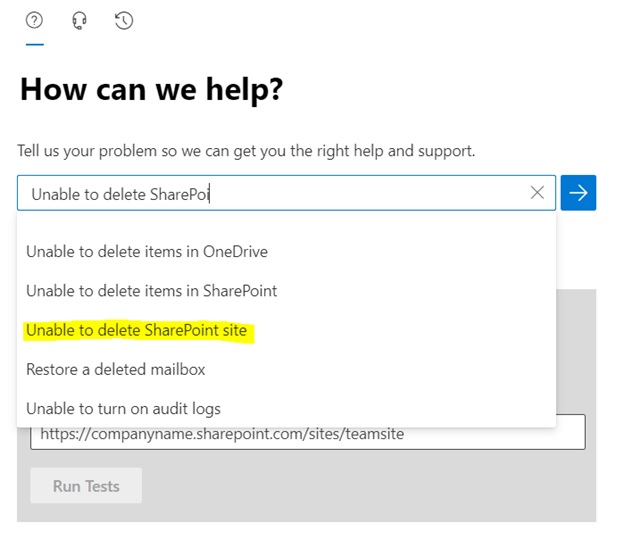
2. Then on this window search for ‘Unable to delete SharePoint site’
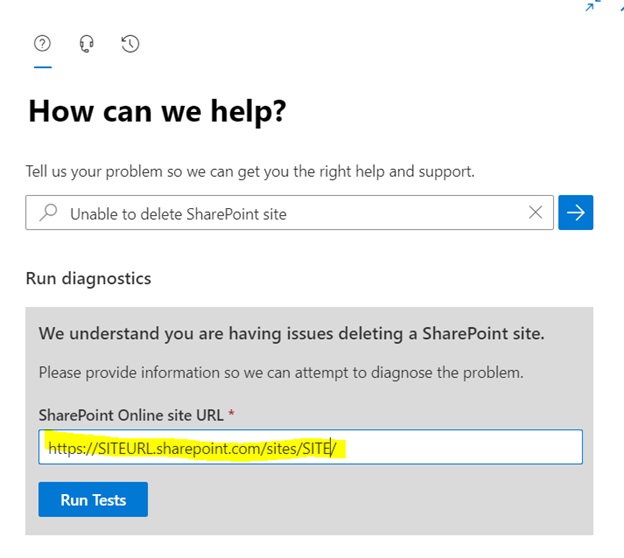
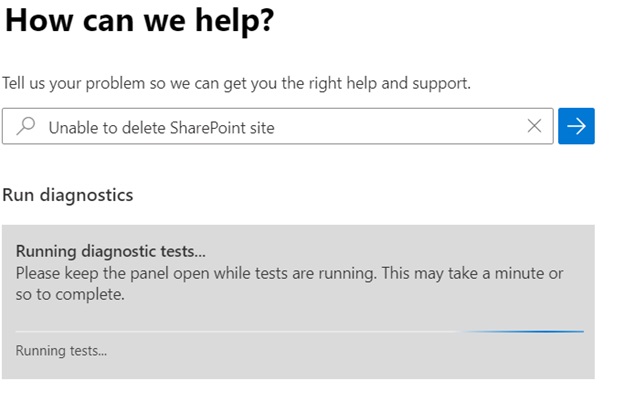
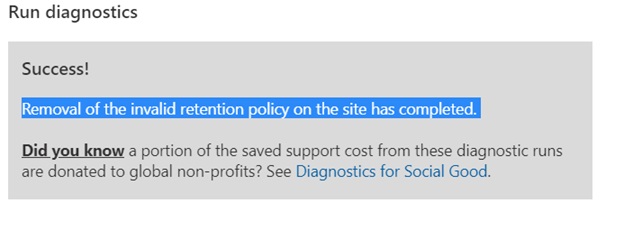

$SiteURL = "https://customersite.sharepoint.com/sites/site"
$ListName = "Preservation Hold Library"
#Connect to PnP Online
Connect-PnPOnline -Url $SiteURL -Interactive
#Delete all files from the library
Get-PnPList -Identity $ListName | Get-PnPListItem -PageSize 100 -ScriptBlock {
Param($items) Invoke-PnPQuery } | ForEach-Object { $_.Recycle() | Out-Null
}
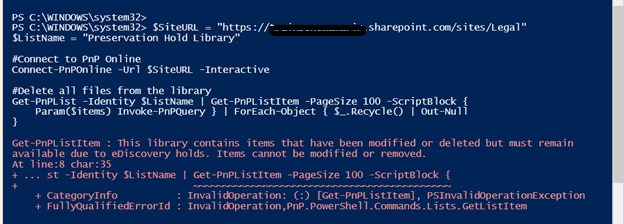
Get-PnPListItem : This library contains items that have been modified or deleted but must remain
available due to eDiscovery holds. Items cannot be modified or removed.
At line:8 char:35
To remove hold on the Preservation, hold library in SharePoint Online, you can follow these steps:
- Go to Microsoft Purview Compliance Portal as a global admin.
- If you have any Retention Policies – Exclude the site from the retention policy.
- If you have eDiscovery cases – Close all eDiscovery cases.
- If you have Data loss prevention policies – Disable them.
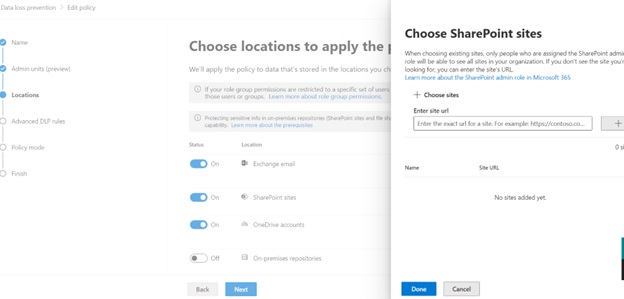
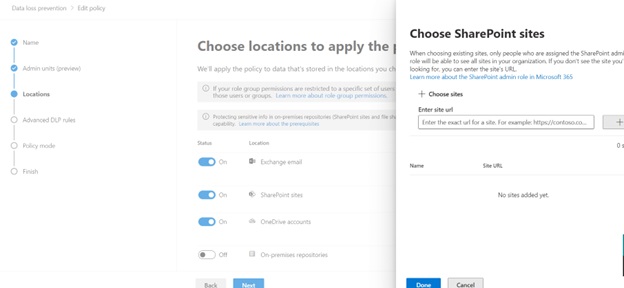
To exclude a site from the retention policy in SharePoint Online, you can follow these steps:
- Go to Microsoft Purview Compliance Portal as a global admin
- Select “Exclude Sites”
- Enter the URL of the site that you want to exclude, and then select the plus (+) button
- Select the check box for the site. You can add other sites if you want
- After you enter all the sites that you want to exclude, select “Exclude” at the bottom of the window to confirm the changes
- Select “Save”
Using Office 365 for information protection and classification
“Secure Your Data with Office 365: Protect and Classify Your Information with Confidence.”
Introduction
Office 365, a resilient cloud-based platform, provides organizations with a wide range of tools for protecting and organizing information. It enables organizations to protect their data from unauthorized access, detect and respond to threats, and classify data based on its level of sensitivity. With Office 365, organizations can verify the security and compliance of their data according to industry standards. This guide will delve into the diverse capabilities and possibilities of Office 365 for safeguarding and categorizing information.
How to Leverage Office 365 for Data Protection and Classification in Your Organization
The protection and organization of data are crucial components of a company’s security framework. As businesses transition to cloud platforms, ensuring the security and accurate categorization of data becomes essential. Microsoft Office 365 provides a wide range of tools to help organizations secure and classify their data.
Office 365 offers various features for safeguarding and categorizing data, aimed at guaranteeing its security. These include encryption, data loss prevention (DLP), and data classification mechanisms.
Encryption is a critical part of data protection. Office 365 implements encryption protocols for data both at rest and in transit, ensuring that only authorized users can access the data.
Data loss prevention (DLP) acts as a safeguard against unauthorized access to sensitive data. Office 365 includes a suite of DLP capabilities, such as detecting and preventing the unauthorized dissemination of sensitive data.
Data classification is crucial for a robust security strategy. Office 365 provides tools to help organizations classify their data, including labeling, content-based classification, and establishing access controls based on data classification.
By leveraging the data protection and classification capabilities within Office 365, organizations can strengthen the security and proper categorization of their data. This enhances the resilience of their data against unauthorized access and ensures its prudent use.
Best Practices for Using Office 365 for Information Protection and Classification
Devise a comprehensive plan to effectively deploy Office 365 for securing and organizing data. This plan must include guidelines for classifying data, outlining who is responsible for categorizing it, and implementing measures to safeguard it.
Utilize Office 365’s built-in security features such as data loss prevention (DLP), encryption, and multi-factor authentication. These powerful tools fortify data protection and limit access to sensitive information to authorized users.
Train employees thoroughly on the criticality of safeguarding and categorizing information. Ensure their comprehension of the policy and adeptness in utilizing the security features inherent in Office 365.
Vigilantly oversee access to sensitive data, guaranteeing that only authorized personnel are granted entry.
Conduct periodic audits of data to validate its correct classification and fortification.
Employ fitting labels to categorize data and ascertain its adequate protection.
Implement suitable permissions to govern access to sensitive data.
Enforce appropriate retention policies to prevent unnecessary data retention.
Regularly scrutinize activity to forestall data misuse or unauthorized access.
Consistently update software to apply the latest security patches and fortify defenses against emerging threats.
By meticulously adhering to these best practices, organizations can ensure the diligent protection and classification of their data while leveraging the Office 365 platform.
Exploring the Benefits of Office 365 for Data Protection and Classification
The preservation and categorization of data stand as paramount considerations for any enterprise. The evolution of technology also brings forth an array of perils to data integrity. Office 365 offers an extensive range of instruments designed to safeguard and label data, thereby guaranteeing the security and adherence of businesses.
Office 365 encompasses an array of data protection attributes aimed at warding off unauthorized access. These encompass encryption, multi-factor authentication, and data loss prevention mechanisms. Encryption serves to render data impervious and incomprehensible to anyone devoid of the requisite credentials. Multi-factor authentication necessitates users to provide additional corroborative elements, such as a code dispatched to their mobile device, before gaining access to data. Data loss prevention serves the purpose of forestalling inadvertent or malicious erasure or alteration of data.
Additionally, Office 365 furnishes an assortment of utilities to facilitate the categorization of data. These utilities enable businesses to classify data in accordance with its sensitivity and significance, ensuring appropriate storage and access protocols. For instance, confidential data can be designated as such, accessible solely to authorized personnel. This framework assures that data remains secure and complies with regulatory standards.
In addition to data protection and classification, Office 365 also provides a range of other features to help businesses remain secure and compliant. These features include advanced threat protection, mobile device management, and compliance management. Advanced threat protection helps to protect against malicious attacks, while mobile device management helps to ensure that devices are secure and compliant. Compliance management helps to ensure that businesses remain compliant with regulations and industry standards.
In summation, Office 365 offers a comprehensive suite of tools to fortify data protection and classification. Not only do these tools assure the security and compliance of businesses, but they also deliver a diverse range of additional features to fortify the security and adherence of enterprises.
How Office 365 Can Help You Classify Your Data for Compliance
Office 365, a robust collection of cloud-based applications, empowers organizations to systematically categorize their data for compliance adherence. Through Office 365, organizations can effortlessly establish and administer data classification policies customized to their unique compliance specifications.
The suite encompasses an array of functionalities tailored to facilitate data classification for compliance. Notably, Office 365’s Data Loss Prevention (DLP) feature enables the formulation of policies for identifying, monitoring, and safeguarding sensitive data. Leveraging DLP, organizations can categorize data based on its content, context, and sensitivity, bolstering the assurance that their data is appropriately classified and shielded.
Further augmenting its utility, Office 365 furnishes an assortment of tools for administering data classification policies. For instance, the Compliance Manager within Office 365 empowers organizations to create, oversee, and monitor data classification policies through an intuitive dashboard, ensuring adherence to established guidelines.
Moreover, Office 365 integrates a suite of security features to fortify data protection. The Advanced Threat Protection feature equips organizations to detect and counteract malicious activities, while furnishing encryption and auxiliary security measures to prevent unauthorized data access.
In essence, Office 365 offers a comprehensive array of features to streamline data classification for compliance. By harnessing these capabilities, organizations can safeguard the proper classification and fortification of their data.
How Office 365 Can Help You Protect Your Sensitive Data
Office 365, a robust suite of cloud-based applications, offers formidable means to safeguard your sensitive data. With Office 365 at your disposal, you can effortlessly store, share, and govern your data within a fortified environment.
The suite boasts an array of security features poised to fortify your data assets. These encompass encryption, data loss prevention, and multi-factor authentication. Encryption serves as a protective shield, rendering data accessible only to authorized users. Meanwhile, data loss prevention shields against inadvertent or malicious data erasure. Moreover, multi-factor authentication acts as a gatekeeper, ensuring that only sanctioned users can access your data.
Office 365 further equips users with myriad tools to vigilantly oversee and administer their data. Users can employ Office 365 to trace data access, surveil data activity, and establish alerts for potential irregularities. Additionally, Office 365 facilitates the implementation of data retention policies to ensure data security and compliance with industry regulations.
Finally, Office 365 provides a range of tools to help you back up and restore your data. You can use Office 365 to back up your data to the cloud, so that it is always available in the event of an emergency. You can also use Office 365 to restore your data from a previous version, so that you can recover any lost or corrupted data.
By taking advantage of the security features and tools provided by Office 365, you can help protect your sensitive data and ensure that it is kept secure and compliant with industry regulations.
Conclusion
Office 365 provides a comprehensive set of tools for information protection and classification. It allows organizations to protect their data from unauthorized access, while also providing the ability to classify and label data for easier management. With Office 365, organizations can ensure that their data is secure and properly managed, while also providing the ability to quickly and easily access the data they need. This makes Office 365 an ideal solution for organizations looking to protect and manage their data.
